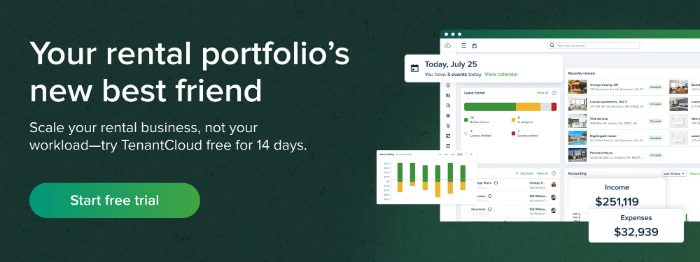Routine Rental inspections are important for both landlords and tenants to make sure the rental is in top shape. These inspections help landlords catch any problems early, stopping them from becoming pricey fixes. For tenants, routine inspections let them flag any worries or issues with the landlord so they can get resolved ASAP.
The last thing a landlord needs is for unreported water leaks to cause mold and mildew damage or for their rental to be accidentally burned to the ground because their tenant routinely smokes inside. A rental inspection can catch those types of issues before they become health and/or wealth hazards.
Likewise, for a tenant, routine inspections can help reduce the risk of having costly charges deducted from the security deposit. They can also identify issues that the tenant may not have even been aware of.
Routine rental inspections are a win-win for everybody.
However, knowing how to inspect a rental property is just as important as the actual inspection.
Types of Rental Property Inspections
In the property management industry, there are different types of rental inspections. Each one has its place and purpose, and there is a different reason behind each inspection type. Here's the breakdown of the different rental inspections that you should be aware of:
Move-in inspection
The move-in inspection typically involves a detailed walkthrough of the rental unit, noting any existing damages, imperfections, or maintenance issues. Both parties should pay close attention to the condition of the walls, floors, ceilings, appliances, fixtures, and any furnishings provided by the landlord.
Move-out inspection
The most routine inspection in the rental industry is the move-out inspection. This inspection is a thorough assessment conducted by the landlord or property manager at the end of a tenant's lease agreement.
During this inspection, the condition of the property is documented to identify any damage beyond normal wear and tear, determine if any deductions from the security deposit are necessary, and prepare the unit for the next tenant.
Routine/mid-lease inspection
Another regular inspection for a residential rental property is the mid-lease inspection. This is a scheduled assessment conducted by the property manager or landlord during the lease term while the tenant resides in the property.
A mid-lease inspection aims to check the condition of the property, identify any maintenance issues or lease violations, and ensure that the tenant is complying with the terms of the lease agreement.
Drive-by/exterior inspection
A drive-by or exterior inspection of a rental property involves visually assessing the property's exterior from the outside.
This type of inspection is usually conducted when a tenant currently lives at the property. However, it's also a good idea to do these types of inspections if your rental is vacant and sitting on the market to make sure it's looking in tip-top shape for showings.
This type of inspection typically focuses on the overall condition of the building, landscaping, and general curb appeal. It allows property managers or landlords to quickly check for any obvious signs of neglect or damage, ensuring the property is being maintained appropriately and in compliance with the lease agreement or property laws.
For example, if the tenant is responsible for mowing the lawn, has that been done lately, or is it overgrown? If you have a landscaping company that's supposed to do it, have they done it on schedule? If so, does it look good?
You'll get these types of answers by doing a quick drive-by exterior inspection of the rental property.
Special Inspections (pests, safety, etc.)
In addition to your standard inspections, you may also have the following special inspections:
Fire Inspections
Most common with multi-family rentals, a fire inspection is when a fire department contacts a property management company (or owner) to schedule a random, mandatory fire inspection of all multi-family rental units. The frequency is typically determined by the city fire code where the multi-family rental is located. The fire department will inspect fire extinguishers, fire escapes, and smoke detectors, among other things.
Pest Control Inspections
If you hire a pest control company to handle your pest control needs, they'll have mandatory inspections conducted every year, which are typically required as part of the agreement you sign with them. This involves an interior inspection and typically a preventative treatment as well.
If you ever encounter an infestation in one rental, all adjacent rentals will likely also need to be inspected and treated to prevent the spread of the infestation to the rest of the building.
Ownership Inspections
If the rental property is being managed on behalf of a third-party property owner, it's not uncommon for the property owner to want to inspect their rental property on an annual or biennial basis. If the owner of the property is trying to sell the rental, it's also common for prospective buyers to want to inspect the rental, especially once it's under contract.
When To Schedule Inspections
In most cases, the property inspection cannot be scheduled outside the hours of 9-5, especially if it involves third parties such as the fire department, pest control, code department, or anybody else.
However, it's important to note that specific inspection notice requirements may vary depending on the state. Your city or county may also have notice requirements for inspections even if your state doesn't.
Let's take Maryland, for example. Even though the state does not have a specific time frame that a landlord must adhere to for giving tenants advanced notice of inspections, Prince George's County does.
If there are laws and ordinances in your area, they typically mandate that tenants be given written notice a certain number of hours (e.g., 24 or 48 hours) before entering the rental unit for non-emergency reasons.
Failure to provide proper notice can infringe on tenant privacy rights and open the landlord up to potential legal issues.
And that is definitely not fun.
Inspection Checklist
Now that you know all about the different types of inspections, the various third parties that might be involved in the inspection process, and the notice requirements for your state or city, next, we'll cover what should be on your inspection checklist in general.
This may need to be tweaked a little based on the type of inspection you're doing, but overall, these are the things you're going to want to check out:
- Overall property condition (interior, exterior, common areas)
- Safety and security (smoke detectors, locks, hazards)
- Plumbing, electrical, and HVAC systems
- Appliances (e.g., are they working, are they being cleaned, etc.)
- Structural integrity (walls, floors, ceilings, water damage)
- Windows, doors, finishes, flooring, blinds
- Exterior maintenance (roof, gutters, drainage, landscaping, etc.)
- Tenant compliance with lease terms (no smoking, pet policies, holes in the wall, etc.)
In fact, we have a move-in/out inspection tool to help guide you through the entire inspection process.
Inspection Protocols
Real estate is governed by a pretty defined set of laws and ordinances, regardless of your rental location. In fact, that's increasingly the case nationwide as housing issues have become a hot topic in the various state legislatures and even in the halls of Congress.
With that being said, it's important to know the ins and outs of the rental property inspection process so that you do not find yourself on the wrong side of the law.
Providing proper notice to tenants
First and foremost, ensure you've followed the notice requirements to a ‘T’ if your state (or city) has a tenant notice requirement before inspecting an occupied rental.
Respecting tenant privacy
There are also laws on the books about what you are, and are not, permitted to inspect in an occupied rental. Make sure you've familiarized yourself with the lease and your local laws.
Most states also have reasonable expectations regarding rental inspections, which stipulate when you can (or cannot) enter the property and how you're allowed to enter.
If your lease has been reviewed and authorized by your local realtor or property management association, it will typically spell out what is permitted during an inspection. If you've written your own lease, it is best to have it reviewed by a real estate lawyer to ensure it has those details included.
Documentation (notes, photographs)
The most important part of the inspection is the documentation part. Without photos, videos, and detailed notes, it's just your word against theirs. Proper documentation protects all parties involved and makes conflict resolution a lot easier.
Proper documentation is important for property managers, tenants, and third parties, too.
Following up with tenants in writing
If there are issues discovered during an inspection, all communication regarding the recently discovered issues should be in writing. If the inspection revealed issues that involve other parties, then that too should be in writing.
If your inspection findings are disputed at any point along the way, your documentation will be incredibly important. It's difficult to dispute something that's clearly visible in videos and photos.
Tenant Rights and Responsibilities
When it comes to property inspections, the owner has the right to inspect their property for reasonable and legal reasons. Even though they own their property and can employ agents to represent them in managing and inspecting their rentals on their behalf, renters still have rights, too.
Here are a few things that are important for tenants (and property managers) to remember:
- Tenants cannot refuse reasonable inspections
- Each state—or even city— may have different guidance on what justifies a reasonable (or legal) inspection.
- Tenants can request to reschedule in most cases
- The property manager will usually work with the tenant's schedule if the request is reasonable and within regular business hours.
- For move-out inspections, the tenant should prepare for the inspection by properly cleaning out the home and following any of the guidelines for moving out as detailed in the lease.
- A security deposit is less likely to have move-out deductions if the tenant moves out on time and leaves the rental in acceptable condition, per the move-out criteria in the lease.
- Tenants are allowed to be present for any inspections during their lease.
- Just keep in mind that not all states require advanced notice of inspections.
- If the property manager violates the law (or the lease), there is almost always legal recourse for privacy violations.
- In many cities of medium to large size, tenants have access to councils and legal support services for issues related to these types of situations.
In Summary: The Benefits of Regular Inspections
In summary, regularly scheduled rental property inspections are an essential part of responsible property management.
They help landlords and property managers maintain the value of their investment, identify and address maintenance issues early, and document the condition of the rental.
Lastly, by understanding the different types of inspections, adhering to all relevant laws and notice requirements, and following a thorough inspection checklist, property owners can ensure their rentals are being properly cared for, and their tenants are upholding their lease obligations.
So, when's your next inspection scheduled for?








